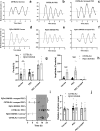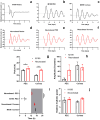Circadian Rhythms in Murine Ocular Tissues Including Sclera Are Affected by Neurobasal A Medium Preincubation and Mouse Strain, but Not Sex
- PMID: 40540259
- PMCID: PMC12184798
- DOI: 10.1167/iovs.66.6.62
Circadian Rhythms in Murine Ocular Tissues Including Sclera Are Affected by Neurobasal A Medium Preincubation and Mouse Strain, but Not Sex
Abstract
Purpose: Our understanding of ocular clocks has been profoundly advanced by the development of real-time recording of bioluminescence of PER2-luciferase (PER2::LUC) knock-in mouse explants. However, the effect of sex, mouse strain, and culturing conditions on ocular clocks remains unknown. Here, we studied the role these variables play on PER2::LUC bioluminescence rhythms of ocular tissues: retinas, corneas, and posterior eye cups (PECs). We also tested the hypothesis that the sclera contains a circadian oscillator by using scraped PECs as a proxy.
Methods: Retinas, corneas, and intact and scraped PECs were obtained from male and female PER2::LUC knock-in mice maintained on either a pigmented C57BL/6J or albino RjOrl:SWISS background. PER2::LUC bioluminescence rhythms in ocular tissues were measured using a Lumicycle.
Results: We compared PER2::LUC bioluminescence rhythms between ocular tissues and found that all ocular tissues oscillated, including the scraped PECs, which were previously not known to oscillate. The rhythms in scraped PECs had lower amplitudes, longer periods, and distinct acrophases compared with other ocular tissues. Immunolabeling revealed the presence of the protein product of the clock gene BMAL1 in the sclera. Ocular tissues of RjOrl:SWISS mice oscillated with higher amplitudes compared with the ones of C57BL/6J, with corneal rhythms being most affected by mouse strain. A 24-hour preincubation with Neurobasal A medium affected rhythms of ocular tissues, whereas sex differences were not detected for these rhythms.
Conclusions: We discovered a novel oscillator in the sclera. PER2::LUC bioluminescence rhythms in murine ocular tissues are affected by Neurobasal A medium preincubation mouse strain but not sex.
Conflict of interest statement
Disclosure:
Figures





Similar articles
-
Feeding regime synchronizes circadian clock in choroid plexus - insight into a complex mechanism.Cell Mol Life Sci. 2025 Jun 23;82(1):247. doi: 10.1007/s00018-025-05798-3. Cell Mol Life Sci. 2025. PMID: 40548998 Free PMC article.
-
Systemic pharmacological treatments for chronic plaque psoriasis: a network meta-analysis.Cochrane Database Syst Rev. 2021 Apr 19;4(4):CD011535. doi: 10.1002/14651858.CD011535.pub4. Cochrane Database Syst Rev. 2021. Update in: Cochrane Database Syst Rev. 2022 May 23;5:CD011535. doi: 10.1002/14651858.CD011535.pub5. PMID: 33871055 Free PMC article. Updated.
-
Antidepressants for pain management in adults with chronic pain: a network meta-analysis.Health Technol Assess. 2024 Oct;28(62):1-155. doi: 10.3310/MKRT2948. Health Technol Assess. 2024. PMID: 39367772 Free PMC article.
-
Systemic pharmacological treatments for chronic plaque psoriasis: a network meta-analysis.Cochrane Database Syst Rev. 2017 Dec 22;12(12):CD011535. doi: 10.1002/14651858.CD011535.pub2. Cochrane Database Syst Rev. 2017. Update in: Cochrane Database Syst Rev. 2020 Jan 9;1:CD011535. doi: 10.1002/14651858.CD011535.pub3. PMID: 29271481 Free PMC article. Updated.
-
Behavioral interventions to reduce risk for sexual transmission of HIV among men who have sex with men.Cochrane Database Syst Rev. 2008 Jul 16;(3):CD001230. doi: 10.1002/14651858.CD001230.pub2. Cochrane Database Syst Rev. 2008. PMID: 18646068
Cited by
-
The modulatory role of short-chain fatty acids on peripheral circadian gene expression: a systematic review.Front Physiol. 2025 Jul 14;16:1595057. doi: 10.3389/fphys.2025.1595057. eCollection 2025. Front Physiol. 2025. PMID: 40727446 Free PMC article.
References
-
- Cox KH, Takahashi JS.. Introduction to the Clock System. Adv Exp Med Biol. 2021; 1344: 3–20. - PubMed
MeSH terms
Substances
LinkOut - more resources
Full Text Sources

